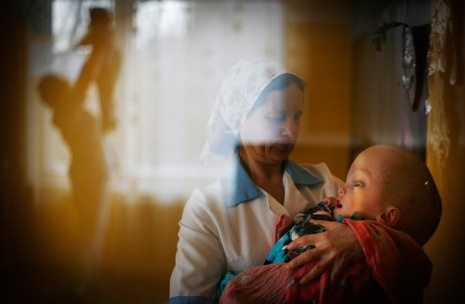
They call it “Sleepy Hollow,” the small village of Kalachi in Kazakhstan, where a strange sleeping sickness leaves inhabitants unconscious for days at a time. The mytsery illness first struck four years ago, and as of September last year, 126 people of the 600 inhabitants had succumbed to the disease. It is like a plague, some villagers say; others believe the illness is caused by radiation blown from the former uranium mines in the now deserted town of Krasnogorsk. Smoke can still be seen billowing from the abandoned mine shafts, where radiation levels at the entrance to the mines are “16 times higher than would be expected from background radiation.”
Yet, this mystery disease appears to have no consistent pathology, and affects people randomly. One might expect the ex-uranium mine workers to be the most likely to be infected, but the majority have no symptoms. Those that have suffered the sleeping sickness, like ex-miner Alexander Ratz, who collapsed after a day-out fishing, have no real explanation for it:
I cast out the fishing rod and felt shaky and dizzy. I caught a fish and started unhooking it. It felt as if I was being pulled into the river, as if evil spirits wanted to topple me. Then I caught another fish. The river started swinging in front of me. I realised something was wrong with me. I felt nauseous. I got in the car, but don’t remember driving at all. I woke up in a ward, surrounded by my mates. The five of us were taken to hospital on the same day. Three days in intensive care.
At first, doctors thought the men had suffered strokes, but as they could walk and talk, doctors were left baffled. Some doctors diagnosed the sufferers with encephalopathy, a disorder of the brain, of unclear origin. After taking scans it was revealed that many of the sufferers had an excessive accumulation of fluid in their brains—known as oedema. While others said it was narcolepsy. But this still did not answer a more troubling question about the men’s strange behavior.
After waking up, the men suffered debilitating cravings for sex.
‘The doctors laugh and the nurses blush when they see our men,’ explained one Kalachi woman.
‘Other women were saying the same. As soon as men were were recovering after waking, they needed sex right there and then, and this feeling lasted for at least a month.’
One man just out of hospital ‘still couldn’t eat properly let alone walk, but he was all over his wife,’ she revealed. ‘He really needed it.’
Some of the men swear, call women “whores” and “prostitutes,” and demand sex. Others rant and rave, shouting obscenities and call out “Heil Hitler.” And there are those who wander about as if “zombies”—in a daze, oblivious to everything around them.
Children afflicted with the disease suffer monstrous hallucinations—see demons or hideous growths sprouting from their mother’s faces. One mother was “dead scared” after being unable to rouse her ten-year-old son Almaz from sleep:
‘I thought at first that he was sick and it was better to let him rest, then I began shaking him, but he would not wake up. It’s really, really scary when your child is suddenly in a coma-like state. Also when they wake up, they behave like sickly babies, they cry without reason just bursting into tears.
‘Like my son, he wanted to get off the bed, but fell down because his legs were too weak. Another burst into tears. And another one when he needs to go to the loo, and he is too weak to make it to the toilet, so he needs to use a hospital potty - and he feels shy and embarrassed by it. How can a mother take it calmly and not be left brokenhearted over this anguish?’
Because of the terrifying after-effects of the illness, Kalachi is now called “Village of the Damned.”
Kazakhstan was once the testing ground for Soviet Russia’s nuclear weapons. Sixty-five years ago, the Soviets detonated its first nuclear weapon, nicknamed “First Lightning”, at a test site “Semipalatinsk Polygon” in northeast Kazakhstan. Over the following forty years 456 atomic explosions were detonated at the site. Many believe these weapons together with the radiation from the Krasnogorsk uranium mines are responsible for the current sickness—citing the generations of children born with defects, cancer and deformities since 1950.
Investigators from the National Nuclear Researching centre of Kazakhstan arrived in Kalachi in 2010 to test the ground and air for radiation. They claim levels are normal, and are at loss to explain what is happening. Carbon monoxide poisoning has been suggested as a factor.
However, some doctors do not believe radiation is the cause:
Kabdrashit Almagambetov, the district’s top doctor, seems genuinely puzzled about what caused this health hazard on his doorstep.
‘It all is very individual, depending on age, the patient’s health condition, what other chronic diseases they have suffered,’ he said. ‘For example, the reaction of children strongly differs from that of adults. Children’s brains have not yet formed fully. They find it harder to tolerate the disease, they have strong hallucinations. Elderly people, too, have hallucinations, because of their age. Frankly, the cause of the disease is still unknown despite the many institutions that have worked here.
‘The radioactive background is normal, all products people are eating have been checked, the water is tested, nothing is harmful there. All those who have been affected are in Kalachi village. True, several people who came from Krasnogorsk suffered from the illness - but only after they visited Kalachi. So the strange effect is noticed only in one village. I can assure you, it is not some mental disorder, it is not some hysterical epidemic, as it was supposed previously.’
He denied it was a psychological illness as some had claimed - ‘only physical’.
‘I cannot say for sure about the radon theory for now, because we need to obtain data from the scientists. I am not a specialist in this question, but I doubt this theory, because we have many closed mines and uranium mines and it is only in Kalachi we faced with such a disease. ‘
He stressed there was no evidence of artificial poisoning, as some villagers suspected.
‘I do not have any working theories, because I am a doctor. I must think how to treat these people, how to help them.’
The lack of information has led to claims that the village has been deliberately poisoned, while one resident told the Daily Mail:
‘It looks like some kind of beam went through the village. I do not know what it can be. Maybe some some special equipment, like emitter. But it all is my speculation. I just see that the location of the homes, where people fell asleep are in straight lines, as if some beam cut through them.’ He warned: ‘I’m not speaking about UFOs. I am simply trying to understand what is going on here.’
As investigations continue and crackpot theories abound, many women and children have left Kalachi to neighboring villages, fearing for their lives, and terrified of changes that have happened to their husbands and menfolk. It is reported that by January 2015, over half the villagers had left Kalachi.
As yet, no one has been able to explain the cause of this strange and terrifying illness.
After the jump, an RT report on Kazakhstan’s ‘village of the damned’










